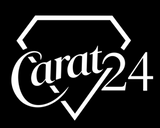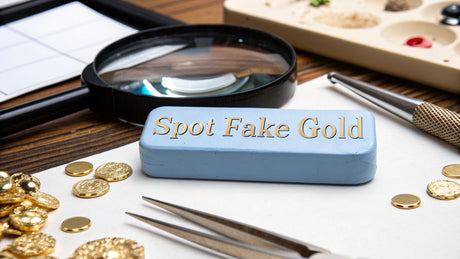Learning how to tell real gold from a convincing fake often starts with a simple, careful look. You don't need fancy equipment for the first pass. Things like discoloration along the edges, a shine that looks a little too brassy, or a missing stamp are immediate red flags you can spot with just your eyes.
Quick Visual Checks for Gold Authenticity
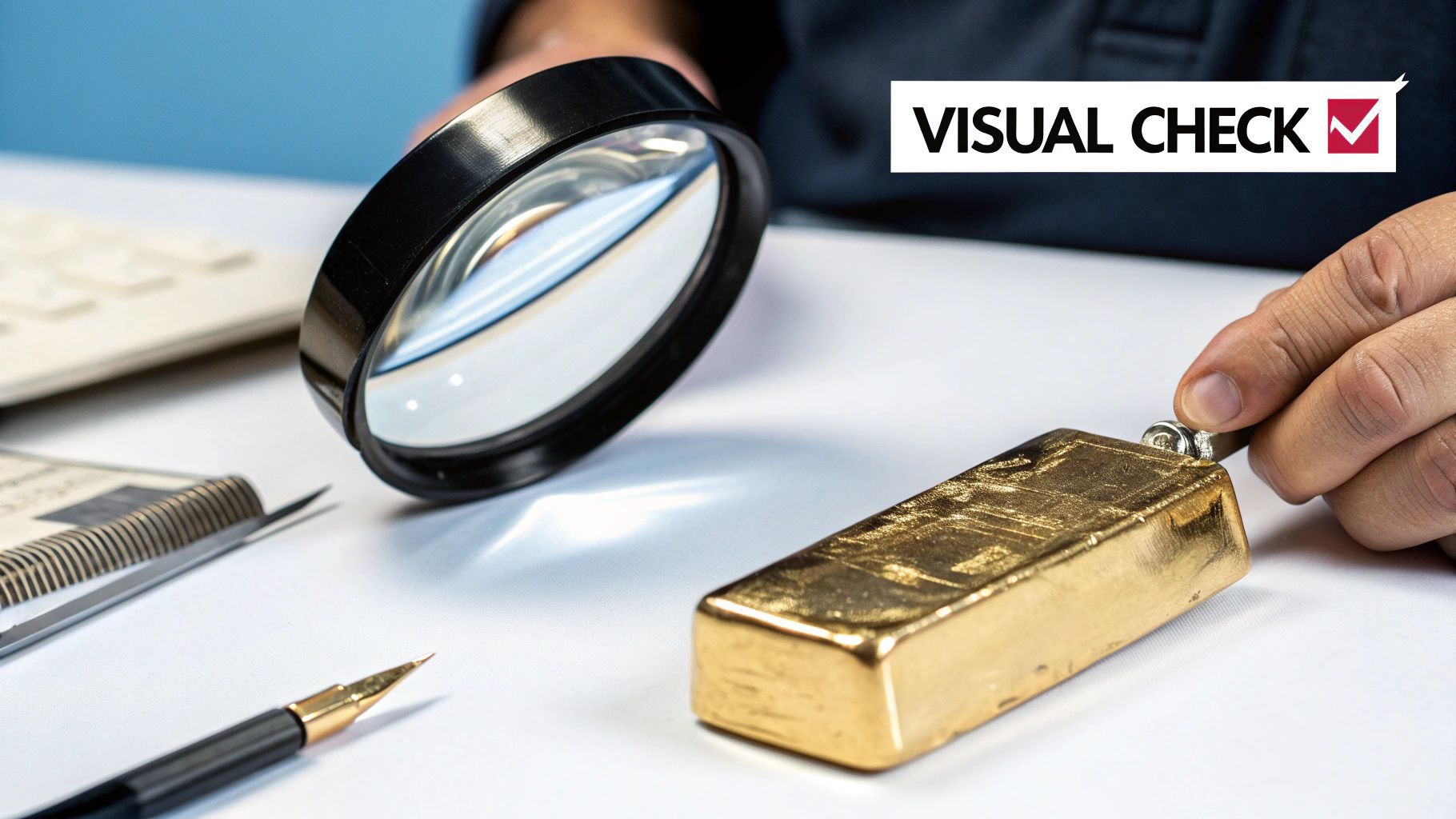
Before you dive into more complex tests, your first and best line of defense is a thorough visual inspection. Think of yourself as a detective looking for clues. The most obvious clue on genuine gold is almost always a hallmark—a tiny stamp that indicates its purity.
Understanding Hallmarks and Stamps
Grab a magnifying glass if you have one and look for small engravings on an out-of-the-way spot, like the clasp of a necklace or the inside band of a ring. This is where the story of the piece begins.
- Karat Stamps: In the United States, you’ll typically find stamps like “10K,” “14K,” or “24K.” The "K" stands for karat, which is a measure of gold purity out of 24 parts.
- Fineness Marks: European jewelry often uses a three-digit number to show purity. For example, “585” means the piece is 58.5% pure gold (the same as 14K), and “750” means it’s 75% pure (equivalent to 18K).
Now, if there's no hallmark, don't panic just yet. It doesn't automatically mean the item is fake, especially with very old, custom-made, or heavily worn pieces. It does, however, mean you should be extra cautious and definitely perform more tests.
Expert Tip: A hallmark is a good sign, but remember, they can be forged. I've seen fake stamps that look incredibly convincing. Never trust a stamp alone to verify authenticity. Always combine your visual check with other methods.
Spotting Telltale Signs of Fakes
Counterfeit gold often betrays itself with small flaws that a trained eye can catch. One of the biggest giveaways is discoloration or chipping, especially around the edges where the piece gets the most wear and tear.
If you see a different colored metal peeking through a gold-colored coating, you're almost certainly looking at a gold-plated item, not solid gold. Real gold is the same color all the way through.
Also, trust your gut about the color. Real gold has a distinct, warm luster that's hard to replicate perfectly. Many fakes have an overly bright, almost brassy shine that just looks off. For anyone involved in Gold and Jewelry Buying, developing an eye for these details is crucial.
Of course, the only way to be 100% sure is to have it professionally tested. If you're in Idaho, you can get free Xray Scanning and Gold Testing for free. We provide hassle free offers so you can save the hassle and sell locally for more than online shipments. We strive to offer the highest payout in Boise with our price matching guarantee.
At-Home Gold Authenticity Checklist
Before bringing your items to a professional, running through these simple, non-destructive checks at home can give you a pretty good idea of what you're dealing with. This checklist summarizes the initial tests you can perform without any special chemicals or tools.
| Test Method | What to Look For | Reliability Score |
|---|---|---|
| Visual Inspection | Hallmarks (karat or fineness), discoloration, chipping, unnatural shine | 6/10 |
| Magnet Test | Strong magnetic attraction (a bad sign) | 5/10 |
| Density/Water Test | How the item displaces water to calculate density | 7/10 |
| Sound/Ping Test | A long, high-pitched ring (good) vs. a dull thud (bad) | 4/10 |
| Ceramic Scratch Test | A gold streak (good) vs. a black streak (bad) | 6/10 |
Remember, these home tests are great for a preliminary assessment, but they aren't foolproof. For high-value items, professional verification is always the best and final step.
Once you've given your piece a good initial inspection, you can dig a little deeper with some simple, hands-on tests. You don't need a high-tech lab for these—just a few things you probably already have at home. Think of these as a good first-pass check before you decide to get a professional opinion.
Simple Magnet, Scratch, and Skin Tests
One of the quickest and safest checks is the magnet test. This one is straightforward: real gold isn't magnetic.
Grab a decent magnet (a strong refrigerator magnet will work just fine) and see if your item reacts to it. If it sticks or you feel a definite pull, that's a red flag. It means there are other metals like iron or nickel mixed in, so it’s not pure gold. Just remember, this isn't a foolproof method since some counterfeiters use non-magnetic metals.
For a test that tells you a bit more, try the unglazed ceramic scratch test. Find an unglazed ceramic plate or tile and gently drag a small, inconspicuous spot on your item across its surface. Real gold will leave a distinct golden-yellow streak. If you see a black streak or any other color, you’re almost certainly dealing with a fake. Be warned: this can lightly scratch your item, so be gentle and only do it if you're comfortable with a tiny mark.
There's also the skin test, which requires nothing but your own body chemistry. Just hold the jewelry tightly in your hand for a couple of minutes until it gets warm. If your skin turns black, blue, or green where it made contact, that’s a bad sign. Pure gold won't react with your sweat, but other base metals like copper and nickel will, leaving a discolored mark behind.
The image below shows another great at-home method—the density test—which is all about comparing your item's density to that of pure gold.
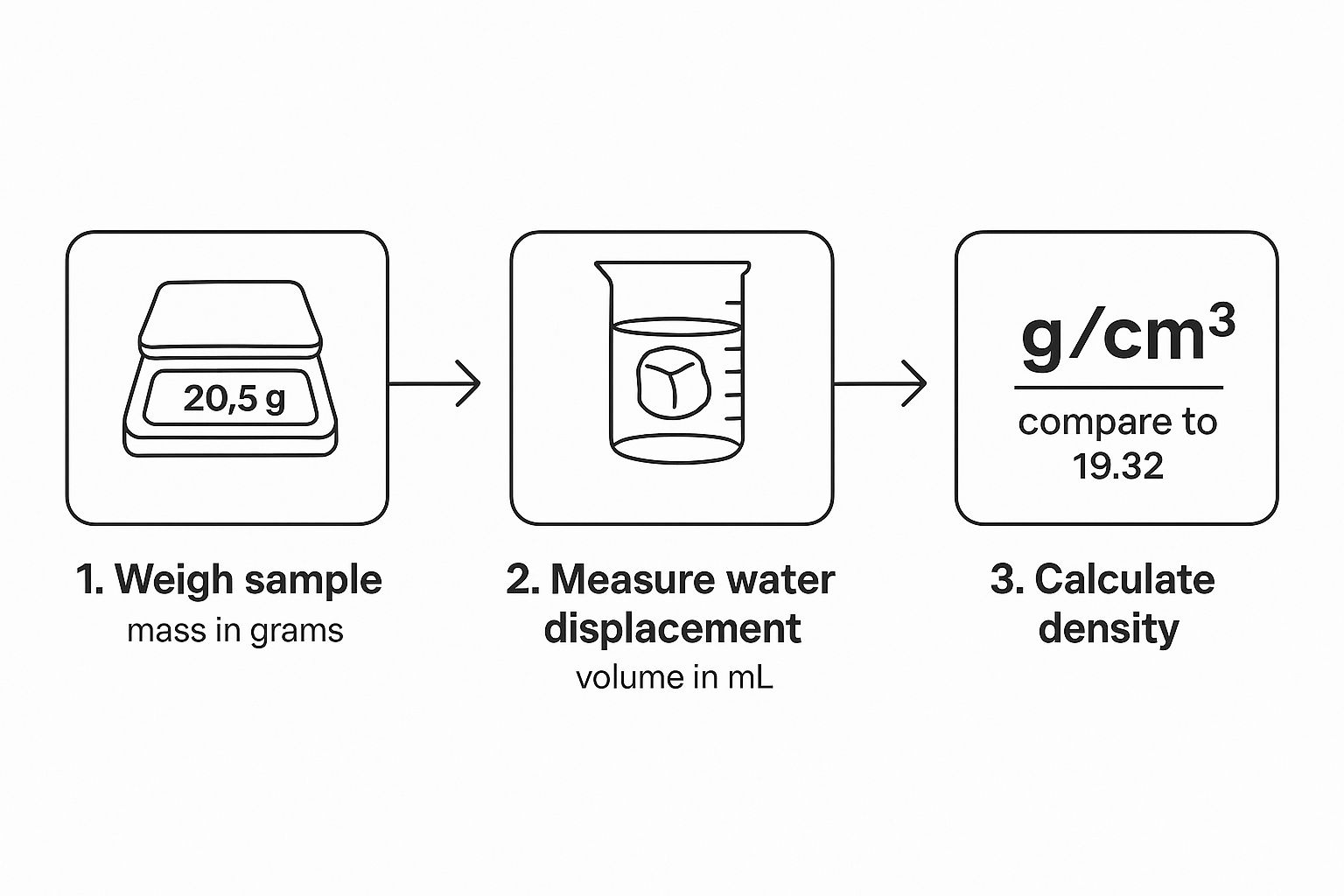
As the infographic explains, if your final density calculation is close to 19.32 g/cm³, you've got strong evidence that your item is the real deal.
While these home tests can offer some valuable clues, even unique gold items like dental crowns need an accurate assessment. You can learn more about what determines the value of a gold tooth in our guide.
Ultimately, for anyone serious about Gold and Jewelry Buying, nothing beats professional verification. If you want to save the hassle and sell locally for more than online shipments, come on down and see us. We offer Xray Scanning and Gold Testing for free for hassle free offers, guaranteeing the highest payout in Boise with our price matching promise.
Uncovering the Science Behind Professional Gold Testing
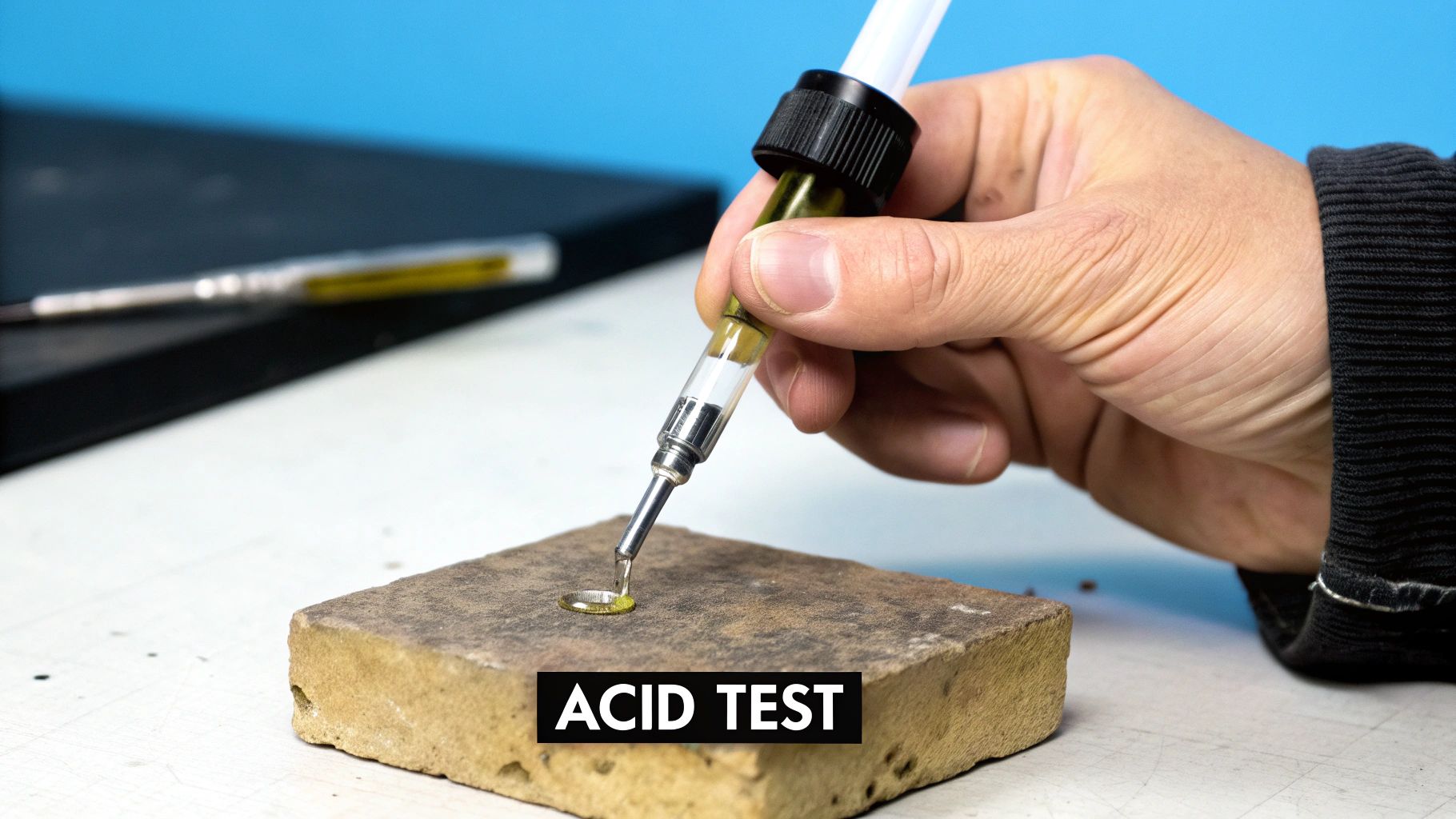
While the at-home checks are fantastic for spotting the obvious fakes, some of the more sophisticated counterfeits require a scientific approach. When you absolutely need to be sure, professionals rely on proven techniques that leave no room for error.
These industry-standard tests go way beyond a simple magnet or a quick visual inspection. They dig into the fundamental chemical and physical properties of gold—the very things that are incredibly difficult for forgers to replicate with any real accuracy.
The Density and Weight Test
One of the oldest and most reliable methods in the book is the density test. It all comes down to a simple fact: gold is uniquely heavy. Pure gold has a specific density of 19.32 g/cm³, and that's a tough number to fake.
A professional will use a high-precision scale and a method called hydrostatic weighing, which involves measuring the item's displacement in water to calculate its density. If that calculation comes back far from the 19.32 mark, you've got a counterfeit on your hands. The best part? It's completely non-destructive and highly effective.
When you need certainty, professional verification is the only way to go. You can save the hassle and sell locally for more than online shipments by getting a free, expert evaluation.
Demystifying the Acid Test
The acid test has been a jeweler's go-to for decades. It's a classic for a reason. This method is all about figuring out the purity, or karat, of the gold.
It works by making a tiny, inconspicuous scratch on the item and applying specific acids that react differently depending on the alloys mixed with the gold. While it's highly accurate, there's a small risk of damaging the piece if it isn't done with a practiced hand. That's why professionals use specialized kits to keep the impact minimal while getting precise results. If you want to learn more about where quality gold comes from, you can explore our guide on Italian gold.
Ultimately, when you need a definitive answer, nothing beats an expert's opinion. Here in Boise, you can get Xray Scanning and Gold Testing for free for hassle free offers. We provide the highest payout in Boise and offer price matching, so you know you're getting the true value for your items without any of the guesswork.
Why Sophisticated Fakes Beat Simple Tests
While the basic at-home tests can certainly catch the most obvious fakes, the world of counterfeiting has gotten incredibly advanced. We're seeing fakes come through our doors that are so well-made they would fool most people, which is why having a professional Gold and Jewelry Buying expert is your safest bet.
To protect yourself, you need to understand the tricks of the trade. The most common method is thick gold plating over a cheap base metal. That layer of real gold is often just substantial enough to pass a simple scratch test, leaving behind that convincing golden streak. This is where a lot of folks get burned, thinking they have a solid piece when it's just a worthless metal core with a fancy jacket.
The Tungsten Deception
A far more devious tactic involves using tungsten, a metal that has almost the exact same density as gold. Fakes made with a tungsten core and a thick gold-plated shell feel shockingly real. They have the right heft and can even pass a basic water displacement test. It's a method that is incredibly difficult to expose without professional equipment.
This isn't just a rare occurrence. We see estimates that approximately 20% of gold items brought into pawnshops fail authenticity checks, and many of them are these sophisticated tungsten fakes. The problem is growing, too. Back in 2023, authorities seized $2 million in counterfeit gold bars made with tungsten cores, proving how convincing these scams have become. You can get more details on these increasingly complex frauds by reviewing the findings on gold testing.
The rise of tungsten fakes proves a critical point: relying on just one or two simple tests isn't enough anymore. This level of diligence is required across all luxury goods; you can read our guide on authenticating Rolex watches to see just how deep the counterfeiting rabbit hole goes.
The best way to avoid these pitfalls is to skip the guesswork. Save the hassle and sell locally for more than online shipments. We offer Xray Scanning and Gold Testing for free to provide hassle free offers, guaranteeing you the highest payout in Boise with our price matching promise.
Get Guaranteed Authenticity with Professional Testing
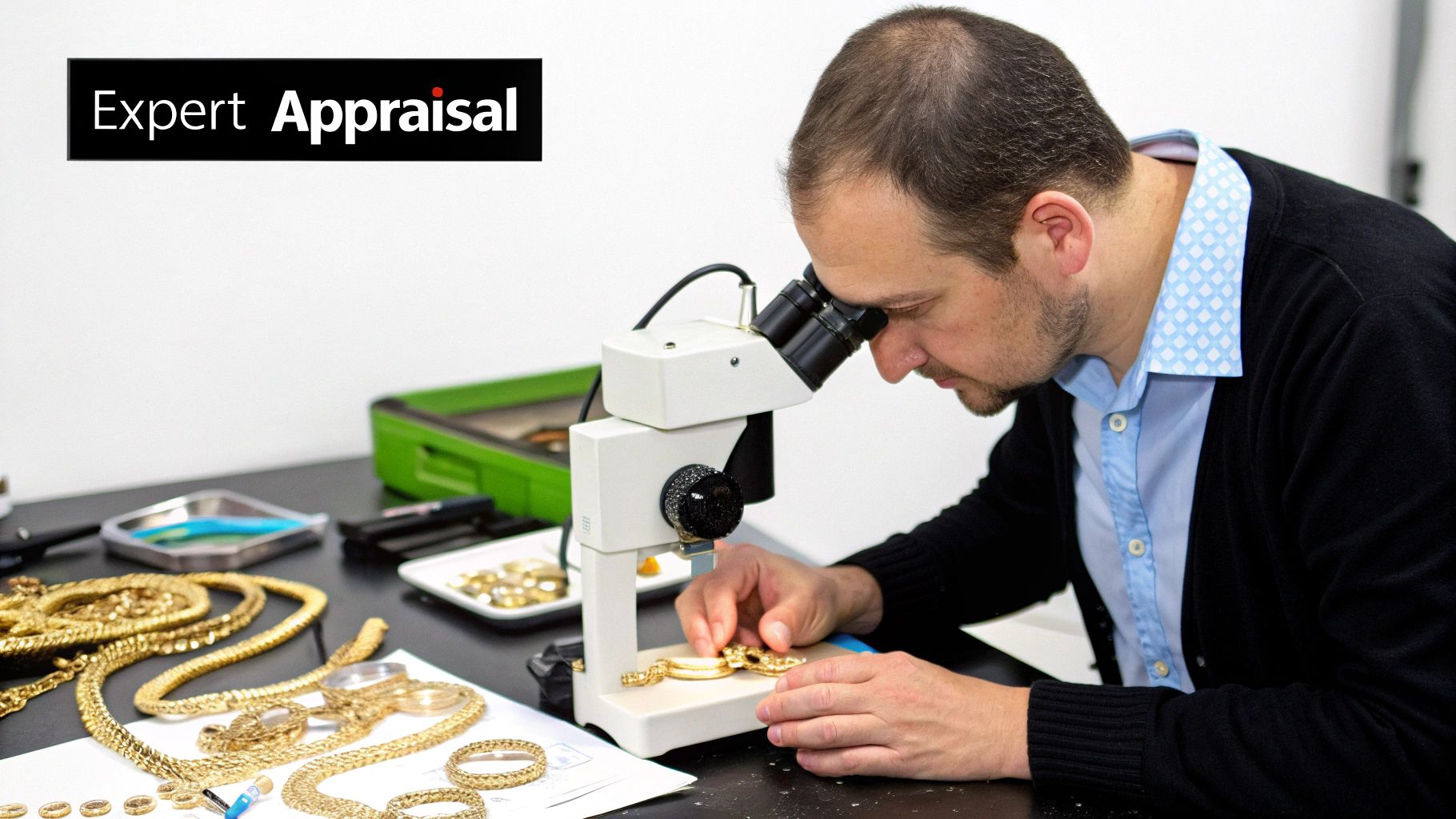
So you've done all the at-home checks, but you're still not 100% certain. When your peace of mind is on the line, the only way to get a definitive answer is to bring in the pros. Nothing beats the precision of modern Gold Testing technology.
For anyone serious about Gold and Jewelry Buying, relying on an expert's analysis isn't just a good idea—it's essential. It's the critical step that takes you from guessing to knowing, which is especially important as the value and complexity of your gold items increase.
The Gold Standard: X-Ray Fluorescence (XRF)
The undisputed champion in the world of professional gold verification is the X-Ray Fluorescence scanner, or XRF for short. This incredible piece of equipment gives a fast, accurate, and completely non-destructive analysis of your item's elemental makeup. Our Xray Scanning is always free.
An XRF machine works by bombarding the item with X-rays, which causes the atoms inside to emit fluorescent energy. By measuring this energy, the machine can identify every single metal present and its exact percentage. That means you’ll know precisely how much gold, silver, copper, or anything else is in your jewelry, all without leaving a single scratch. This level of precision is vital, particularly for tricky lower-karat pieces.
Recent studies confirm what we see every day: while traditional tests are useful, advanced tools like XRF scanners offer far higher accuracy. This is especially true for gold below 10K, where alloy variations can easily skew the results. For a deeper dive, you can learn more about the scientific advancements in determining gold content.
Expert Take: An XRF scan removes all doubt. It instantly tells us if an item is gold-plated, what the base metals are, and confirms the exact karat purity. It’s our ultimate tool for guaranteed authenticity.
Why Professional Local Testing Is Your Best Bet
Trying to navigate the complexities of buying gold, especially from other countries, can be a minefield. This is exactly why getting it verified locally is so important. If you've ever wondered about deals abroad, you might find our article on whether gold is cheaper in Mexico an interesting read.
For our neighbors in Boise, getting that certainty is simple. You can save the hassle and sell locally for more than online shipments. We provide Xray Scanning and Gold Testing for free right here in our shop, ensuring you get hassle free offers and the absolute highest payout in Boise. We even offer price matching to guarantee you get the best possible value for your precious items.
Gold Testing FAQs
When you're dealing with gold and jewelry, a little bit of knowledge goes a long way. Let's tackle some of the most common questions we get asked—clearing things up so you can make decisions with confidence.
Can I Trust the Hallmark or Stamp on My Jewelry?
Think of a stamp like "14K" or "750" as a good starting point, but never the final word. Scammers have gotten incredibly good at forging these marks to make a cheap piece of metal look like the real deal.
Treat the hallmark as just one clue. For real peace of mind, you have to combine that visual check with other tests, like the magnet test or getting an expert evaluation. Our Gold and Jewelry Buying experts can help.
The most convincing fakes often have the most convincing stamps. Never rely on a hallmark alone—verification is key.
I've seen it countless times: a heavy, thick chain with a perfect "18K" stamp that's just worthless plating over a base metal. This is exactly why you need more than one way to verify your gold. Also, remember that pieces from other countries can have different markings, so knowing what's underneath is crucial. You can see how this works by checking out our guide on the gold content in Mexican coins.
What Is the Most Reliable Way to Test Gold at Home?
If you're looking for the most accurate test you can do yourself, the density test is your best bet. It's incredibly difficult for counterfeiters to fake gold's unique density of 19.32 g/cm³ (though tungsten comes very close). The catch is that you need a very precise digital scale and have to be careful with your measurements.
Want something simpler? The magnet test is fantastic. It won't give you a definitive "yes," but it's a great first step that instantly weeds out fakes made with magnetic metals like iron or nickel. For a definitive answer, bring it in for our free Xray Scanning.
Is It Better to Sell My Gold Locally or Online?
Selling your gold locally is almost always the smarter, safer, and more profitable way to go. You can save the hassle and sell locally for more than online shipments, completely avoiding the stress and risk of mailing your valuables away.
When you work with a trusted local Gold and Jewelry Buying expert right here in Boise, you get an immediate, hassle free offer. We provide Gold Testing for free using professional equipment like Xray Scanning to guarantee you get an accurate value. Plus, with our price matching promise, you can walk away knowing you received the highest payout in Boise.
When you're ready to sell your gold, silver, or fine jewelry, don't leave its value to chance. Visit Carat 24 - Trusted Gold Experts for a transparent and profitable experience. Get your free, no-obligation offer today!
